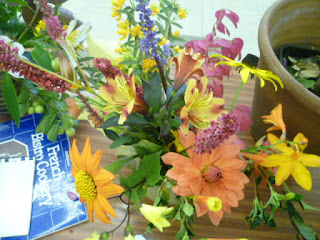Presentation: Kew through the seasons by Ken Matthewman
 |
| Ken, who describes himself as a horticultural maniac, has been gardening since a child and rose from a humble indentured apprentice with Castleford Borough Council to working at Kew Gardens. |
Ken’s illustrated talk gave us a real
insight into Kew along with its history.
Beginning as a 12 acre totally flat, sandy river floodplain, it now
spans 300 acres of landscaped gardens, with research facilities and a gallery
of Marianne North’s paintings. Also to be
found here are trees from every species, a new state-of–the-art alpine house,
and the Palm House, originally built in the 1840’s from steel and glass. Ken advises that a full day should be set
aside for a visit to the gardens, where every plant is labelled and new bedding
schemes are always being trialled.
Display
Table
 |
| Marjorie and Brian’s Coleus plants grown from “babies” |
 |
| Ann found a new-to-her plant at The Arium nursery. Lindernia grandiflora, perhaps not aptly named, but also known as Blue moneywort False pimpernel and Angels Tears |
 |
| Margaret H asked for identification of this plant which she grew from red berries. Anyone? |
Gardening
Matters
Have a look at someone else's "display table".
Notice
Board
Gill has ordered stocks of tulip bulbs
again this year for purchase at the next meeting.
Next
Meeting
2nd
November: A celebration for the 50th
anniversary of the Society moving into our current premises. John
M Sheard FRICS, a former resident Land Agent of the Bolton Abbey Estate, will
give a talk on ‘The Life and Achievements of Joseph Paxton’
16th November: Harvest Forum – Brexit Bash and Bring &
Buy. Further details to be advised.



















